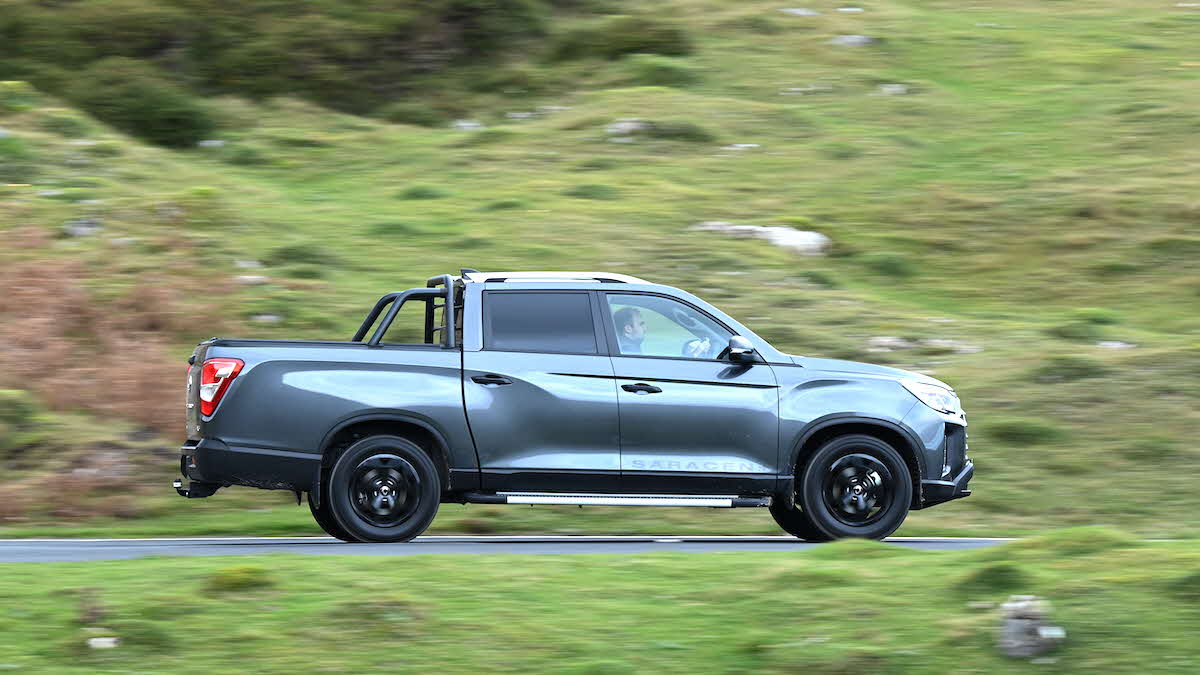New and used
Browse for bargains from thousands of new and used vehicles for sale, or sell your caravan, motorhome, towcar or accessories.
Buy and sell nowJames Batchelor tests the long-wheelbase version of a highly competitive pick-up

No, your eyes aren’t deceiving you – we have reviewed a SsangYong Musso in this magazine before, and that test car was even painted in the same Marble Gray. This is a newly updated model, and it’s also the first time we have been behind the wheel of the long-wheelbase version of this much-loved pick-up.
For this update, SsangYong hasn’t touched the truck’s exterior styling, and that’s a good thing because the Musso has always had a very distinctive look. It features most of the same bodywork up to the rear doors as the Rexton SUV, which is unusual as pick-ups from Ford, Toyota and Isuzu are all bespoke vehicles. But the imposing slatted grille, beefy arches and high ground clearance really catch the eye.
Unlike those aforementioned rivals, the Musso is unique in that it comes in two different lengths.
The standard model has a 130cm-long load bed but the Saracen+ adds another 31cm making its loading area the longest of any pick-up on sale. It’s wide too, which is a big boon if total loading space is a priority. What’s more, the Saracen+ has an extra 5mm of ground clearance compared to the standard-load-bed Mussos.
For this update, SsangYong has been spending its time on the inside, as evidenced by a whole new dashboard. The previous car’s buttons to control the air conditioning and heating have been replaced with touch sensitive ones, and the air vents are now in a neat vertical row as the touchscreen has been placed on top of the dashboard. There’s nothing fancy about the infotainment system, but the screen’s wide 12.3in screen is useful for the TomTom sat-nav system, and it looks great when connected to (standard-fit) Apple CarPlay or Android Auto.
Prior to the arrival of the new Ford Ranger and Volkswagen Amarok twins, the Musso had the plushest interior of any pick-up on sale. Although the former have moved the game on in terms of pick-up interior quality and design, the Musso’s cabin is still well screwed together and doesn’t feel cheap. The Saracen+ is the only trim level on offer for the long-wheelbase Musso, featuring soft Nappa leather seats. Space in the back is decent enough – there’s room for a couple of six-foot-tall passengers.
The only options on our test car were the metallic paint, a roll cover (£1,498 excluding VAT), top roll cover sports bars (£698 exc VAT) and the towing equipment, which comprised a fixed towbar for £398, 13-pin wiring kit at £274, and caravan extension wiring (to power a caravan’s fridge, leisure battery, and so on) for £103 (all exc VAT).
Naturally, just like with its rivals, there’s a plethora of top boxes and accessories available to personalise the Musso to your needs, but even with add-ons you’ll likely be surprised at the Musso’s price. Our test car came in at £37,835 (exc VAT).
The Musso comes with just one engine option. It’s a 178bhp 2.2-litre four-cylinder diesel, which can come with a six-speed manual gearbox on entry-level, standard-load-bed Mussos, but is exclusively paired with a six-speed auto on the higher trims including the Saracen+.
It’s a fine engine. It can feel a little coarse when accelerating from a standstill – especially when hitched – but there’s a decent slug of torque between 1,600 and 2,600rpm, which can motor the big SsangYong quite nicely, especially when overtaking slower moving traffic on the motorway.
The steering is very light and doesn’t provide much in the way of feedback (few pick-ups do), while road and engine noise are well suppressed when cruising, making for a quiet, enjoyable driving experience.
The only black mark is for ride quality – surprisingly SsangYong fits coil springs for its rear suspension instead of the usual leaf springs. In theory this should result in a more balanced, car-like ride quality, but it doesn’t – it has been tuned to be firm, in order to cope with heavy loads, so when you’re driving unladen the rear end is very stiff and unforgiving. It’s by no means a deal breaker, but just something that’s worth remembering – a Toyota Hilux or Ranger have a more compliant, forgiving ride, for example.
The Musso has impressed us when hitched in the past and the same was true in this test. It has a kerbweight of 2,195kg, so sticking to the Club’s 85% guidelines, most caravans will be a match for the big SsangYong. The Musso tows very confidently – there’s only the occasional tug when overtaking large vehicles such as lorries, but it’s nothing to write home about.
In some large SUVs and pick-ups, switching to four-wheel drive mode gives more balanced handling, but that’s not needed with the Musso. A chunky knob on the centre console can switch the car to four-wheel drive high and low, but we found the Musso to be more than capable in two-wheel drive mode.
The only tweak we had to make was to the gearbox – ‘power’ mode usefully sharpened up the gear changes compared to the default ‘eco’ mode, but even with this change the Musso’s gearbox can be a little hesitant at times. It’s a shame because the engine performs well when towing, feeling punchy and responsive enough.
The SsangYong Musso remains a hugely competent and impressive pick-up. It may not have the star quality of a Ford Ranger, but it has great credentials. Factor in low prices and a five-year warranty and the Musso is highly recommended if you need a dual-purpose tow vehicle.
Photography by Nathan Morgan